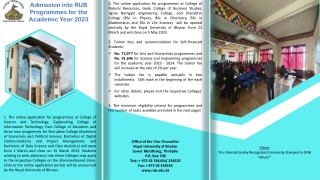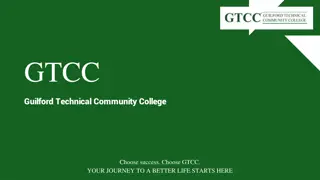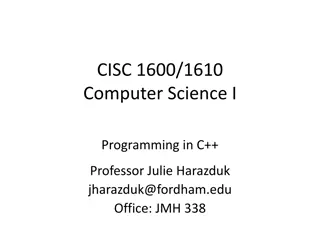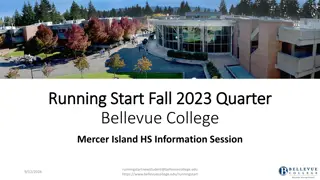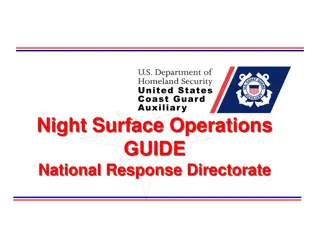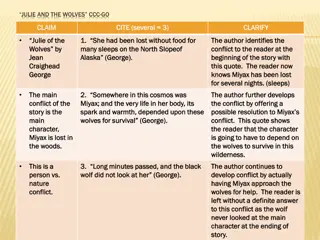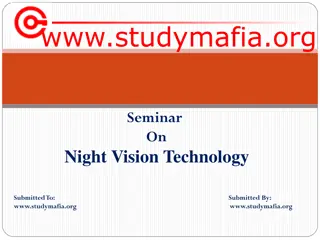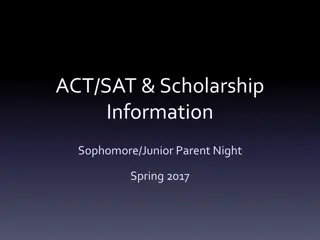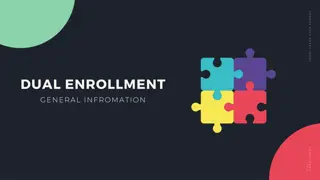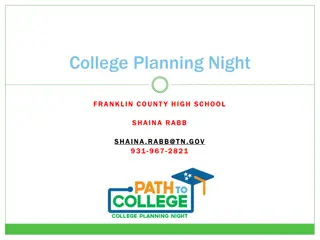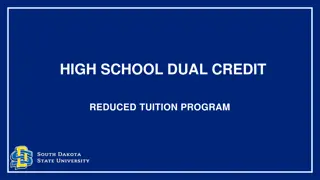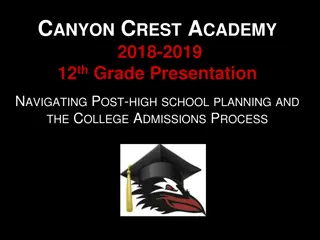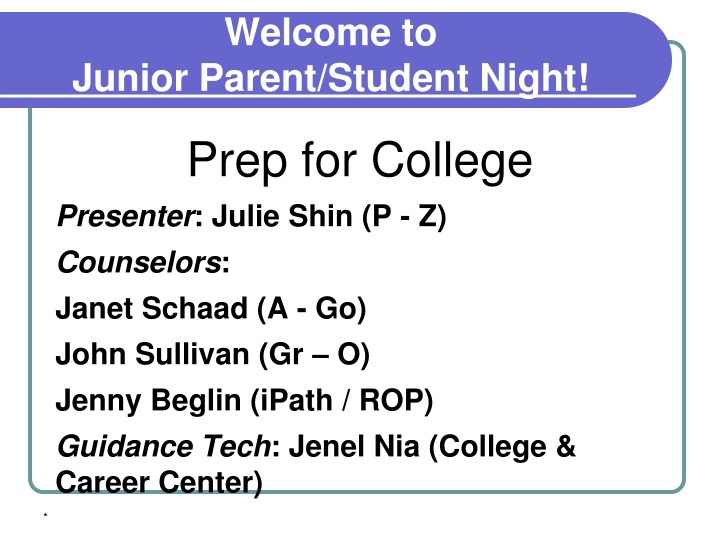
Insights on College Readiness, Testing, and Types for High School Juniors
Get ready for college with information on CAASPP/EAP testing, college types like UC and CSU, and understanding the criteria for college readiness based on test scores and GPA. Prepare for the transition into higher education as a high school junior.
Download Presentation

Please find below an Image/Link to download the presentation.
The content on the website is provided AS IS for your information and personal use only. It may not be sold, licensed, or shared on other websites without obtaining consent from the author. If you encounter any issues during the download, it is possible that the publisher has removed the file from their server.
You are allowed to download the files provided on this website for personal or commercial use, subject to the condition that they are used lawfully. All files are the property of their respective owners.
The content on the website is provided AS IS for your information and personal use only. It may not be sold, licensed, or shared on other websites without obtaining consent from the author.
E N D
Presentation Transcript
Welcome to Junior Parent/Student Night! Prep for College Presenter: Julie Shin (P - Z) Counselors: Janet Schaad (A - Go) John Sullivan (Gr O) Jenny Beglin (iPath / ROP) Guidance Tech: Jenel Nia (College & Career Center) *
Agenda CAASPP / EAP Testing for Juniors College types SAT vs ACT Timeline: Spring, Summer, Fall Naviance More To Come Questions
CAASPP / EAP This Spring Test dates will be in early April CAASPP testing replaced the STAR test for CA high school juniors. The results on the exam are used as part of the Early Assessment Program with the CSU system. Thus, students need to take the CAASPP very seriously and do their best on the exam.
CAASPP / EAP & College Readiness College Readiness CAASPP Level / Test Scores Next Steps READY EAP Standard Exceeded English: ACT 22+, SAT 500+ AP Lang/Lit: 3+ Math: ACT 23+, SAT 550+, AP Calc or Stats: 3+ May enroll directly in college level courses upon admission to CSU CONDITIONALLY READY EAP Standard Met English: ACT 19-21, SAT 460-490 Math: ACT 20-22, SAT 490-540 English: 12thgrade ERWC, AP, or IB Math: 12thgrade course with Alg 2 prerequisite NOT YET READY* EAP Standard Nearly Met or Not Met English: (at or below) ACT 18, SAT 450 Math: (at or below) ACT 19, SAT 480 Take EPT and/or ELM Exams Exempt = College Ready Not Exempt = Early Start Program *Students who are deemed Not Yet Ready are more likely to spend more time in remedial courses and thus spend more money in their undergraduate years. For example, graduating in 6 years as opposed to 4 will result in: ~Approximately $16,000 extra per year for two years (~$30,000.00)
College Types UC CSU Western Exchange Community College Private Trade / Technical
University of California Serves top 1/8 of high school graduates MINIMUM GPA of 3.0 to apply Comprehensive Review includes: a - g courses in grades 10 11 Number of a - g and AP/Honors courses SAT or ACT with Writing scores (single best sitting) Quality and rigor of the senior year Extra-curricular activities, special talents, leadership experience, insight questions *
UC Eligibility in the Local Context Top 9% ELC from high school identified by self-reported grades on UC app and: Must have completed 11/15 a - g courses Must have at least a 3.0 GPA Results shown on Application Status page after application deadline and review. Applications will be automatically screened by UC system upon submission.
UC Entering Class of 2016 Admit rate ranged from 18% at UCLA to 76% at Merced Average GPA range was 3.36 at Merced to 4.31 at Berkeley & UCLA Average test score range was 22/1650 at Merced to 32/2070 at Berkeley. Average cost of attendance for the UC system is $33,000 *
UC best bets Do the best you can in a - g courses Take advantage of other academic/ leadership/unique opportunities Take SAT or ACT in junior year. Continue to retest to get best scores and complete testing in Nov/Dec of senior year Remember SAT subject tests are no longer required, but suggested for Engineering and science majors Apply to numerous UC campuses
California State University Serves top 1/3 of high school graduates CSU admissions based on a - g s , GPA(10th&11th), and test scores. Requires SAT or ACT without writing-either is accepted Students ranked on Eligibility Index (formula based on GPA/SAT/ACT calculation) Average cost from $19,628 (Monterey Bay) to $26,158 (SDSU) on-campus per year. CSUF commuter $16,410 per year. Early Assessment Program (ELM and EPT) tests taken by all juniors in spring this is the CAASPP! Early Start Program - mandatory remediation during summer after graduation *
CSU Impaction: IMPACTION DOES NOT MEAN IMPOSSIBLE Number of eligible candidates far exceed the number of spaces and instructional resources 2 categories of impaction Impacted Majors - if you don t get your 1st choice, you may be moved to an alternative major Impacted Campus - impaction is a protection of over crowding & about being able to serve admitted students. *
CSU Best bets Do the best you can in a - g courses. Take other courses related to your major interest. Continue to retest to get the best scores & complete testing in Nov. of senior year. SAT subject tests are not required, but may be suggested for impacted majors. Apply to numerous CSU s including local admissions area school -CSUF *
Western Undergraduate Exchange (WUE) Residents of WICHE states may enroll at participating two- and four-year college programs outside of their home state at a reduced tuition rate. WICHE states include: Alaska, Arizona, California, Colorado, Hawaii, Idaho, Montana, Nevada, New Mexico, North Dakota, Oregon, South Dakota, Utah, Washington, Wyoming. WUE gives students from WICHE states affordable access to programs that may not be available in their home state or that are not impacted. Website: wiche.edu/wue *
Private/Independent Colleges 75 Independents in California alone 9 out of 10 students receive financial assistance Most schools guarantee 4 year graduation Every admission file is personally reviewed- can show demonstrated interest Classes are smaller, personal attention Costs and admissions standards vary widely Test scores can open access for merit aid *
California Community Colleges All students should take a - g requirements, especially MATH if they wish to be in a Transfer Program. Counseling 100 for seniors at SOHS Transfer Programs/AA & AS/Certificates Average cost $1400/year No SAT or ACT testing required *
Trade/Technical Schools Specialty schools such as Le Cordon Bleu in Pasadena, Fashion Institute of Technology in LA, etc. All have different entrance requirements - check with admissions Most have financial aid available as well Be cautious of for-profit schools *
ACT/SAT All colleges accept either/both tests Official testing starts in Spring and goes through December of senior year Try both tests and decide which one is best for you-that is the one to prep/retest SAT II Subject Tests- recommended for STEM majors- Math Level II and science. Can take 3 in 1 sitting. *
SAT/ACT Practice Test at SOHS Saturday, Feb. 25, 2017 Location: Career Center Time: 7:45 am to 12 pm Bring: Calculator, Pencils, Snack (optional) FIRST 30 to sign up! Sign up by EMAIL jshin@fjuhsd.org or at Ms. Shin s office.
Financial Aid & Scholarships Free Application for Federal Student Aid (FAFSA) and CSS profile Factors that determine a family s financial strength Schools determine distribution of funds as financial aid packages Research independent sources of scholarship funding Athletes should register with the NCAA Financial Aid Night in October with Ms. Nia
Timeline: Spring Review graduation requirements College Visits Look for scholarships / speak with Ms. Nia Naviance- College Search & Supermatch May start Counselor Questionnaire Think about teacher recommendation letters NCAA Clearinghouse (eligibilitycenter.org) SAT March 11, May 6, June 3 (collegeboard.org) SAT Subject Tests May 6, June 3 ACT April 8, June 10 (act.org) Finish Jr. Year STRONG!
Timeline: Summer Log onto Common App (after August 1st) (www.commonapp.org) Work on essay Visit more colleges (Reach, Match, Likely) Register for September ACT, October SAT Work on Counselor Questionnaire
Timeline: Fall (Seniors Already?) STUDENTS SHOULD: Make an appointment with their Guidance Counselor in the fall after completing Naviance and counselor questionnaire tasks Early Action/Early Decision deadlines require an earlier meeting Participate in the Guidance College Visits!!!!!! If a student has a school on their list Request transcripts through Guidance Office Take SATs/ ACTs again in fall if you need or want to Send official SAT/ACT scores to colleges through collegeboard.org and act.org
NACAC tips for parents: Dos and don ts for college admissions Do learn about the college admission process Do discuss restrictions up front Don t limit choices based on fees Do remind your child of deadlines Do listen and offer advice when asked Don t make decisions for your son or daughter Do encourage and celebrate
Parent Responsibilities Review Naviance- help student develop a list of prospective schools Help student think of majors to apply under Accompany student on college visits
Return to Homepage Naviance Family Connection https://connection.naviance.com/family-connection/auth/login/?hsid=sonorahigh Email: Long ID; Password: Short ID (numbers only!)
Return to Homepage What Does It Do?
Return to Homepage What Does It Do? Produces scatter grams of acceptances, denials, waitlists
Return to Homepage What Does It Do? It tells you how you can send applications
More To Come. PSAT results will be dispersed this month SAT/ACT Practice Test & Scoring with Ms. Shin (Feb. 25) Junior meetings in the Career Center with Ms. Shin & Ms. Nia students will sign into Naviance, find the counselor questions, and explore colleges. We will meet again with them as Seniors in the Fall. We will meet with each senior in the fall with specifics on graduation and/or the application process.
Thank you for attending! General Q & A 10 minutes If you have a specific question about your student, please set up an appointment with your student s counselor. *

